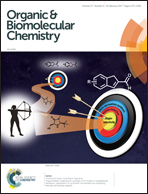Nucleophilic ring-opening reactions of trans-2-aroyl-3-aryl-cyclopropane-1,1-dicarboxylates with hydrazines†
Abstract
trans-2-Aroyl-3-aryl-cyclopropane-1,1-dicarboxylates when treated with arylhydrazines in refluxing EtOH gave dihydropyrazoles, whereas with hydrazines in refluxing AcOH, they formed cyclopropane-fused pyridazinones. Although in both cases the corresponding hydrazones are formed initially, the former case involves a subsequent 5-exo–tet nucleophilic ring-opening, and the later, a 6-exo–trig nucleophilic attack by the other hydrazone nitrogen. The products are obtained in moderate to excellent yields with complete regio-and diastereoselectivity.



 Please wait while we load your content...
Please wait while we load your content...